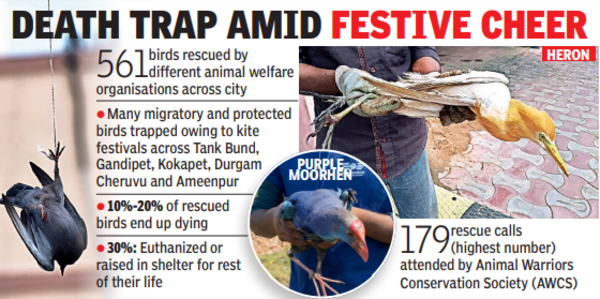Manja Threat: Skies Turn Into No-fly Zone For Birds In City | Hyderabad News
According to various animal welfare organisations, a total of 561 birds entangled in Chinese manja were rescued during the current Sankranti season across the city, with a fatality rate of 10 to 20%.

A total of 179 rescue calls, which were the highest number, were attended by Animal Warriors Conservation Society (AWCS). They have witnessed several migratory and protected resident birds like kites and eagles falling prey to the synthetic manja.
“After two years of Covid-lull, this time the Chinese manja menace returned with a vengeance. We have rescued spot-billed pelicans, purple moorhen, black kites, cattle egret, little egret, barn owls, spotted owlet, green bee-eater and great cormorant,” founder and president of AWCS Pradeep Nair told TOI.
As per rules, after rescue and treatment, these birds have to be handed over to the Nehru Zoological Park. Animal activists said that owing to Chinese manja, there is a massive toll on the number of unrescued birds. This year, several raptor species were left disabled for life not by getting entangled with manja on trees but by having their wings cut by Chinese manja.
“We rescued 12 eagles and three kites this year. Usually, we get rescue calls for pigeons but this time it was for raptors. Welfare workers state that many kite festivals, which have taken place around Tank Bund, Gandipet, Kokapet, Durgam Cheruvu and Ameenpur where migratory birds tend to nest, resulted in many protected birds falling victim. Even small birds like parakeets and kingfishers too got injured by the thread,” Soudharm Bhandari of the GHSPCA told TOI.
Soudharm said the number of bird rescue calls this year has substantially risen compared to previous years. At least 36 protected birds under schedule I and III of Wildlife Protection Act, 1972 have fallen prey to the nylon and synthetic threads. Majority of them have permanent wing damage with most forced to live the rest of their lives in captivity, he added.
Source link





